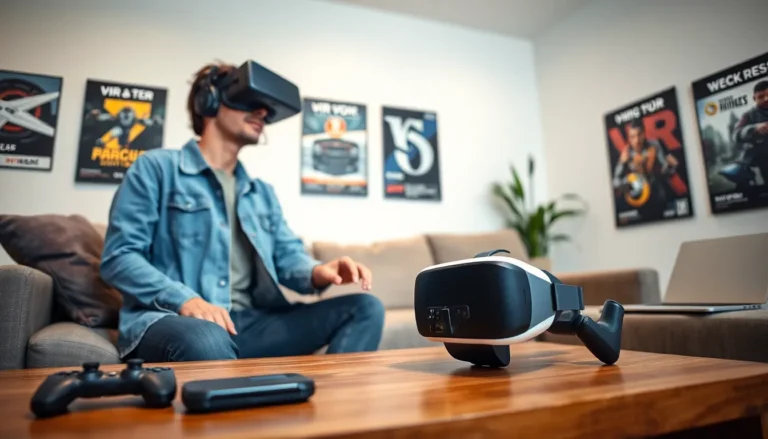In the epic showdown of smartphones, two titans stand tall: iPhone and Samsung. Each brand boasts a loyal following, like fans of rival sports teams, ready to defend their favorite device with the passion of a thousand keyboard warriors. But which one truly deserves the crown?
Table of Contents
ToggleOverview of iPhone and Samsung
iPhone and Samsung represent two of the most prominent smartphone brands available today. Both brands enjoy a dedicated and passionate following. Users often express loyalty towards either Apple’s iPhone or Samsung’s Galaxy series.
Apple’s iPhone stands out for its seamless integration of hardware and software. Known for its user-friendly interface, iPhones simplify navigation and enhance user experiences. The operating system, iOS, also benefits from regular updates, ensuring optimal security and performance.
Samsung, on the other hand, offers a diverse range of devices catering to varied preferences. The Galaxy series features numerous models, each with distinct specifications and price points. Samsung’s Android platform provides flexibility through extensive customization options, appealing to tech-savvy users.
Camera quality serves as another significant factor for many consumers. The iPhone excels in producing natural colors and optimizing image processing software. Samsung frequently includes cutting-edge camera technology, often delivering impressive zoom capabilities and ultra-wide lenses.
Battery life represents another critical aspect as well. Users typically find that Samsung smartphones tend to feature larger batteries, providing longer usage times. Conversely, iPhones often implement efficient power management, balancing performance with longevity.
Pricing structures also differ considerably. The iPhone generally exists at a premium price, reflecting Apple’s branding strategy. Samsung, however, offers devices across various price ranges, accommodating budget-conscious customers.
Both iPhone and Samsung possess distinct strengths that appeal to different user needs. This rivalry continues to evolve as each brand strives to innovate and enhance its offerings.
Design and Build Quality
Design and build quality significantly influence consumer preference between iPhone and Samsung. Both brands showcase distinct aesthetics and materials that appeal to different demographics.
iPhone Design Features
iPhones are renowned for their sleek, minimalist design. The aluminum and glass construction exudes sophistication, enhancing user appeal. Each model features precise craftsmanship with attention to detail, providing a premium feel. Dimensions vary slightly, yet the iconic design remains consistent across generations. Color options, including Space Gray, Silver, and Gold, cater to diverse tastes. The absence of bezels enhances screen visibility, making user experience more immersive. Notably, iPhones maintain durability through Ceramic Shield glass, which offers enhanced drop protection.
Samsung Design Features
Samsung devices feature a blend of modern aesthetics and practicality. Curvature in many models provides a unique ergonomic grip alongside captivating visuals. Material choices include glass and metal, which contribute to a premium look. Commonly, Samsung offers a wider array of color options, appealing to users seeking personalization. The inclusion of Infinity Display technology results in a borderless screen that maximizes viewing area. Build quality emphasizes durability, with Gorilla Glass used to resist scratches and damage. Flagship models often include design innovations like foldable displays, showcasing Samsung’s commitment to innovation.
Performance Comparison
Performance remains a critical factor when comparing the iPhone and Samsung smartphones. Both brands continually push boundaries through innovative technology and optimization.
Processor Overview
Apple’s A-series chips dominate benchmark tests due to their exceptional performance. The latest A16 Bionic chip delivers impressive speed and efficiency, enhancing overall user experience. Samsung utilizes its Exynos and Snapdragon processors, which also offer competitive performance. Devices with the Snapdragon processor often excel in multitasking and gaming scenarios. Each processor type serves distinct functionalities while maintaining high performance standards.
RAM and Storage Options
iPhones typically feature 4GB of RAM, optimized for iOS efficiency. Efficient memory management ensures smooth app performance despite seemingly lower RAM compared to Samsung’s offerings. Samsung, on the other hand, provides models with up to 12GB of RAM, catering to users who prioritize heavy multitasking. Storage options vary, with iPhones offering configurations up to 1TB and Samsung providing expandable storage via microSD cards for added flexibility. These differences in RAM and storage significantly influence user experience and performance.
Camera Capabilities
Camera capabilities play a crucial role in the ongoing smartphone debate between iPhone and Samsung. Each brand brings unique advantages that appeal to different users.
iPhone Camera Performance
iPhone cameras excel in producing natural colors and realistic image processing. Apple’s integration of software ensures seamless functionality, with features like Smart HDR and Night Mode enhancing photos in various conditions. The latest models boast powerful lenses that deliver impressive low-light performance and consistent quality across all scenarios. Portrait mode creates stunning images that beautifully blur backgrounds. Users often appreciate iPhone’s ability to capture vibrant yet true-to-life images, making it a favorite among photography enthusiasts.
Samsung Camera Innovations
Samsung pioneers advanced camera technology with features that enhance versatility and creativity. The brand’s flagship models often include impressive zoom capabilities, with some devices offering up to 100x digital zoom. Ultra-wide lenses capture expansive landscapes, making them ideal for group photos or stunning cityscapes. Additionally, Samsung incorporates innovative techniques like Super Steady video stabilization for smooth recording experiences. Photography enthusiasts notice the variety of customizable settings, allowing for tailored shooting experiences that cater to unique preferences.
Software Experience
Software experience plays a vital role in smartphone usability. Distinct OS platforms create different interactions for users.
iOS vs. Android
iOS offers a cohesive ecosystem for iPhone users. Regular updates enhance security and provide new features. Apple’s App Store features numerous high-quality applications designed specifically for iOS. In contrast, Android’s flexibility caters to a broader range of devices, including Samsung smartphones. Users benefit from customizable interfaces and alternative app stores. The choice between iOS and Android often hinges on personal preferences for stability and customization.
User Interface Differences
iOS presents a straightforward interface with clean designs, ensuring accessibility. Users enjoy a consistent layout across apps, simplifying navigation and onboarding. Samsung’s user interface, One UI, focuses on customization, allowing users to modify themes, icons, and layouts. This provides a personalized experience but may require some adjustment for new users. Overall, iOS emphasizes simplicity while Samsung embraces flexibility. Both interfaces cater to varying user needs and preferences, ultimately influencing the overall software experience.
Battery Life and Charging
Battery life significantly impacts smartphone usability, and both iPhone and Samsung take different approaches.
iPhone Battery Performance
iPhone models generally focus on efficiency rather than size. The A-series chips optimize power management, extending battery life during intensive tasks. Users can expect about 15 to 20 hours of usage on a single charge, depending on the model and usage habits. Fast charging features are included, with many models supporting up to 20W charging speeds, allowing a quick recharge when needed. Apple’s commitment to battery longevity pairs well with regular iOS updates that enhance overall performance.
Samsung Battery Technologies
Samsung devices often come equipped with larger batteries, ranging from 3,000mAh to 5,000mAh, catering to power users. The brand employs advanced charging technologies, including fast charging and wireless charging capabilities. Users enjoy the benefit of adaptive battery features that optimize usage based on habits, potentially increasing overall longevity. Key models also support power sharing, allowing users to charge other wireless devices on the go. Samsung’s focus on battery capacity and innovative charging solutions appeals to users seeking extended usage.
Price and Value
Pricing varies significantly between iPhone and Samsung, reflecting their market strategies. iPhones typically command a premium price, with models ranging from $699 to $1,099 at launch. Samsung, however, offers devices across a broader spectrum, from budget-friendly options starting around $199 to high-end flagship models priced similar to the iPhone. This diversity allows consumers to select a device that suits their financial constraints and preferences.
Cost Comparison
Cost differences play a crucial role in user decisions. For example, the iPhone 14 starts at $799, while the Samsung Galaxy S23 begins around $799 as well. Various mid-tier Samsung options, like the Galaxy A53, offer solid performance at around $349. These price points indicate that Samsung caters to a wider demographic, making technology accessible for more users compared to Apple’s more streamlined offerings.
Long-term Value Retention
Long-term value retention varies between the two brands. iPhones generally maintain higher resale values due to brand loyalty and consistent demand. For instance, an iPhone may retain up to 60% of its original value after two years, while a Samsung device might hold around 50%. Apple’s reputation for software updates also enhances long-term usability, ensuring devices remain relevant. Conversely, Samsung’s models provide features catering to changing user needs, potentially enhancing value for tech enthusiasts who prefer cutting-edge technology.
Choosing between an iPhone and a Samsung smartphone ultimately depends on individual preferences and needs. Those who value a seamless ecosystem and user-friendly interface may lean towards the iPhone. Its consistent performance and software updates create a reliable experience.
On the other hand, Samsung appeals to users seeking customization and variety. With its diverse range of devices and advanced camera features, Samsung caters to tech enthusiasts and budget-conscious consumers alike.
Both brands continue to push the boundaries of technology, ensuring that users have compelling options regardless of their choice. Whether it’s the premium feel of an iPhone or the innovative features of a Samsung device, users are bound to find a smartphone that fits their lifestyle.




